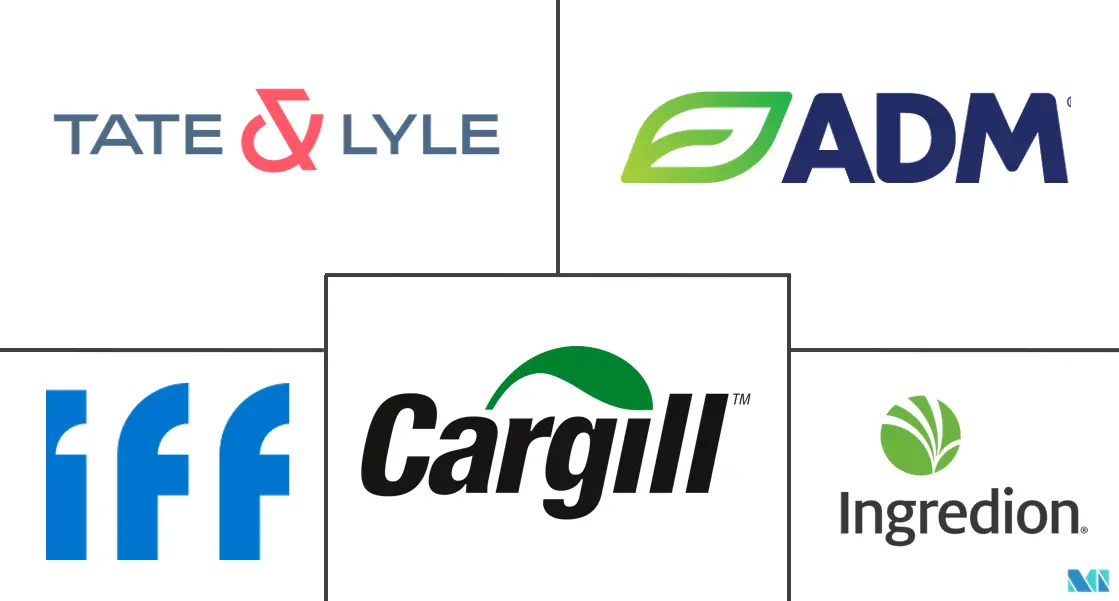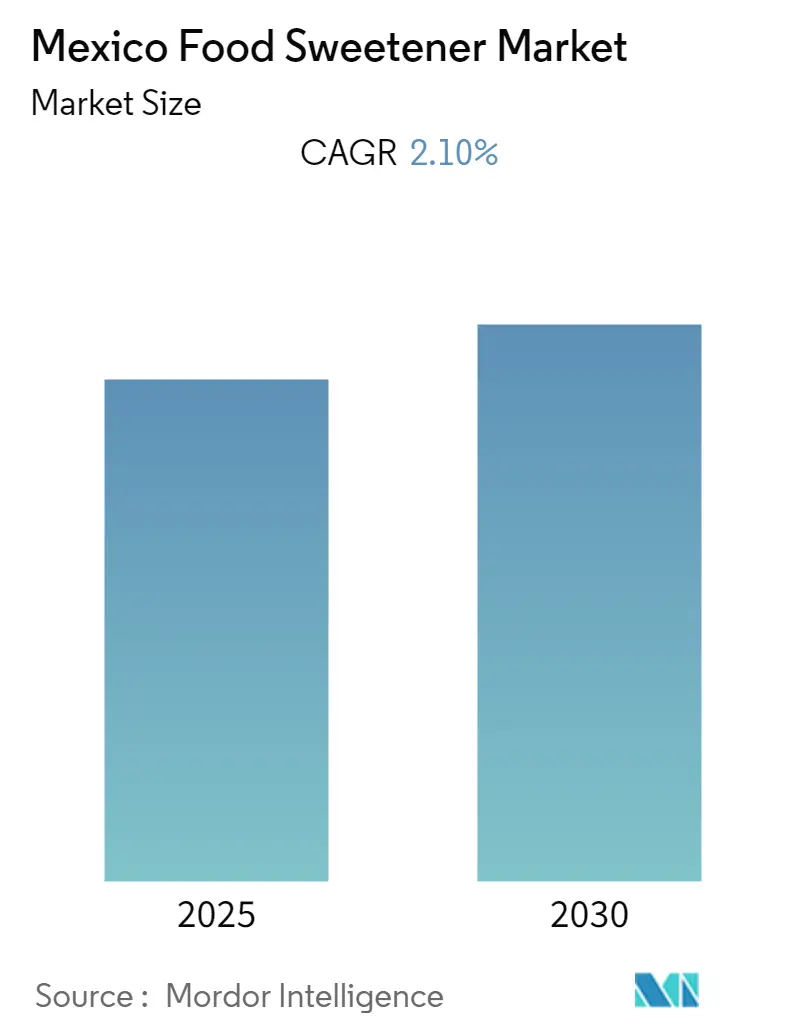
Mexico Food Sweetener Market Analysis by Mordor Intelligence
The Mexico Food Sweetener Market is expected to register a CAGR of 2.1% during the forecast period.
The increasing concern regarding the prevalence of obesity is encouraging consumers to opt for natural and zero-calorie sweeteners, such as stevia. Furthermore, the consumption of sugar substitutes, such as xylitol, erythritol, and mannitol, is rapidly increasing across Mexico. This is attributed to consumer awareness, government regulations to reduce sugar consumption, and application in many health and wellness food products in the market. The inclination toward low-calorie sweeteners and low-calorie beverages, such as diet coke and low-calorie drinks, and low-calorie foods, such as yogurt, ice cream, and grain-based desserts, has gained popularity worldwide. The physiology of sweetness receptors is also being studied in greater detail, with an endeavor to make foods and beverages sweet without using sugar.
Increased demand for natural non-caloric sweeteners and the high demand for sweeteners in various applications, such as processed foods and beverages from emerging economies, are the major factors driving the market growth. However, an increase in awareness about the negative effect of sugar on consumers' health is likely to hinder the market growth, thereby providing more opportunities for low-calorie sweeteners, especially in bakery, beverage, and dairy products.
Moreover, to control health issues such as diabetes and obesity, in January 2014, the Mexican government implemented a 10% tax on industrialized sugar-sweetened beverages to curb obesity and diabetes. Similarly, the Mexican government wanted to bring down the calorie count of most foodstuffs to a maximum of 284 calories per kilogram. Therefore, it established a sugar tax of one peso per liter for every product that surpassed this limit. Many drinks and food manufacturers incorporated stevia to comply with this law and avoid the tax. Thus, it increased the demand for sugar alternatives in the country.
Mexico Food Sweetener Market Trends and Insights
Rising Trend of Clean Label and Plant-based Ingredients
The low-sugar, naturally sweet, plant-based ingredients witnessed a growing demand in the market, with monk fruit and stevia being two high-intensity plant-based sweeteners approved by FDA GRAS. Also, the demand for clean-label or natural food products is rising in Mexico, owing to the growing consumer awareness about the negative health effects of artificial ingredients. According to the International Diabetes Federation, 16.9% of the population in Mexico suffered from diabetes as of 2022.
Consumers demand clean labels on products to gain knowledge about the product that they are about to consume. The inclination toward identifying the ingredients present in food and beverage has fueled the growth of the clean-label ingredients market. Consumers are ready to pay a premium price for naturally sourced ingredients. Growing health consciousness among consumers has led them to grow cautious over the high consumption of sugar. As per Gabinete de Comunicación Estratégica, last year, 40% of Mexicans preferred eating healthy/healthy diet, and 1.7% of the people avoided drinking soft drinks. Sugar can be replaced or is claimed to be replaced by healthier clean-sounding alternatives, such as stevia, to cater to the demand of consumers seeking clean-label/plant-based sweeteners.
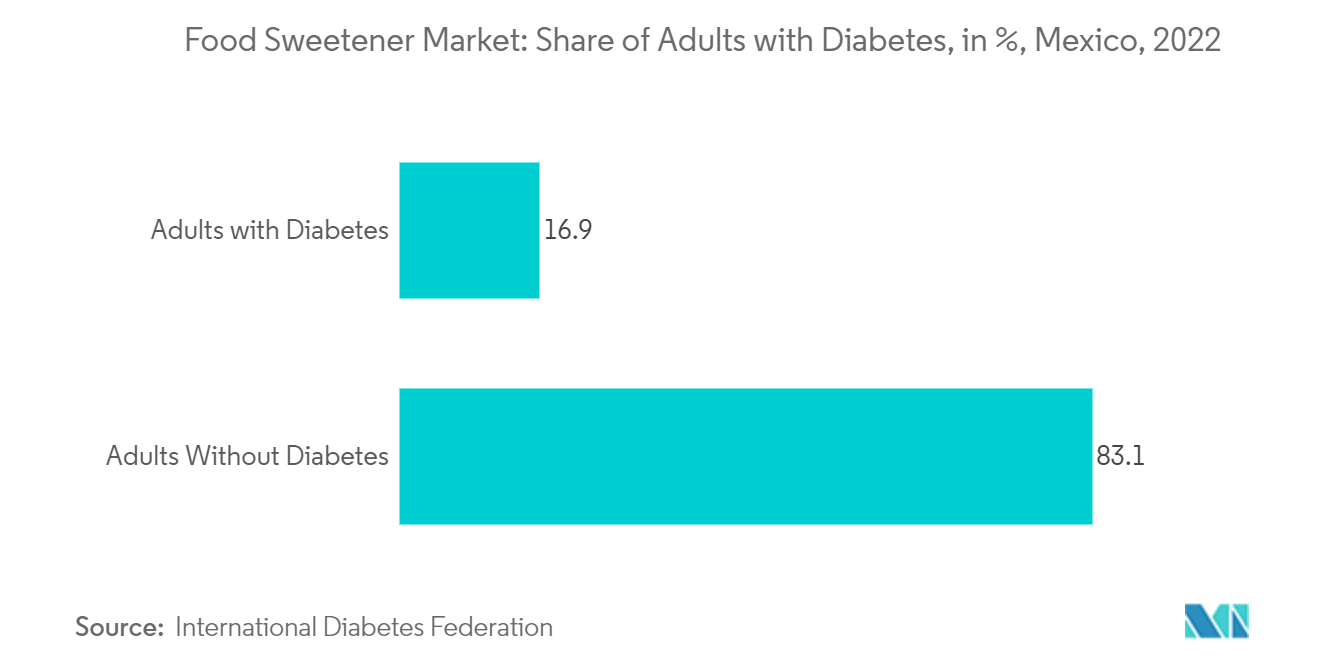
Major Application of Sweeteners in Beverages
There is a high demand for sweeteners from the beverage industry, and aspartame and sucralose are some of the popular sweeteners that are used as sugar substitutes in soft drinks, especially in carbonated beverages. According to INEGI (The National Institute of Statistics and Geography), the sales value of soft drinks and other non-alcoholic beverages in Mexico in July 2022 was MXN 24,752 million.
Furthermore, diet cokes are getting popular among youth and the working population across Mexico, where diet cokes are made with sugar substitutes, such as sugar alcohols and high-intensity sweeteners, which in turn, is propelling the market's growth gradually. Moreover, the amount of sugar can also be reduced without changing the taste and appearance, thereby encouraging beverage manufacturers to substitute sugar with low-calorie sweeteners. The reduced cost of production and better economy of scale are also fueling the growth of sweeteners. New product innovations, such as beverages with the incorporation of stevia, are also attracting the attention of consumers who are seeking natural ingredients in their products.
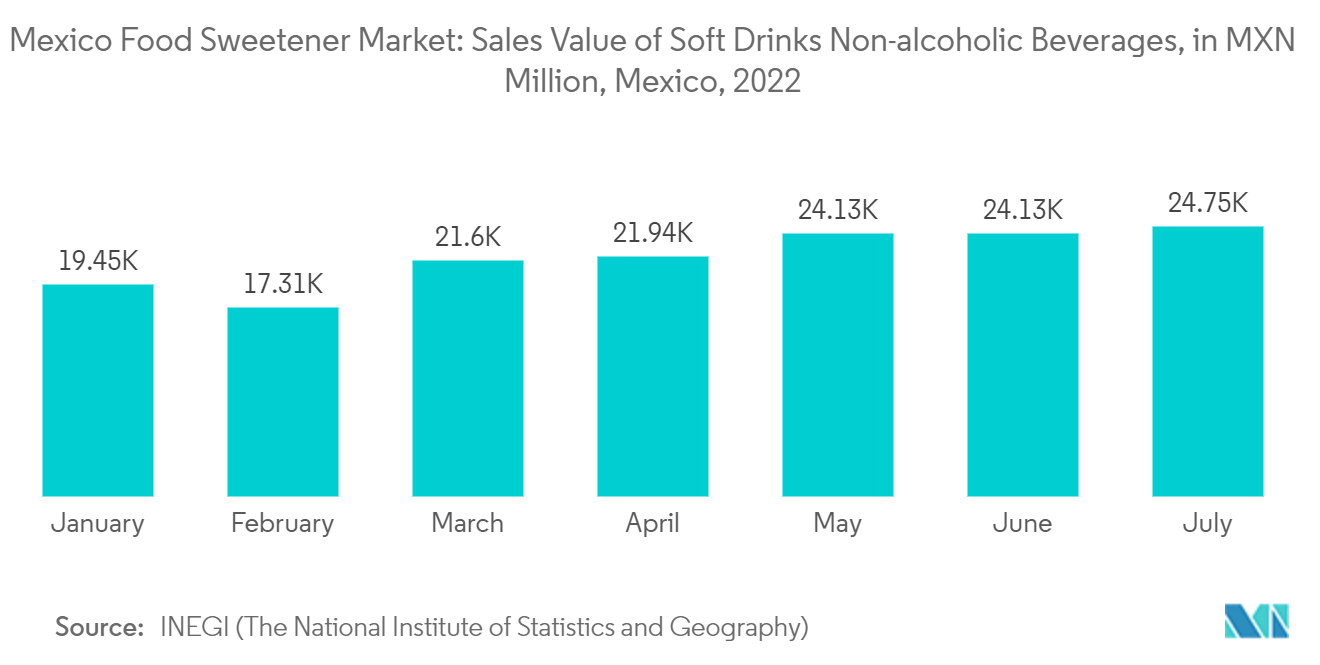
Competitive Landscape
The Mexican food sweetener market is highly competitive and fragmented, with the presence of several players. The key players are adopting strategies, such as partnerships, expansion, mergers and acquisitions, and new product launches to strengthen their position in the market. The players dominating the market are Cargill Incorporated, Tate & Lyle PLC, Ingredion Incorporated, International Flavors & Fragrances, and Archer Daniels Midland Company. Additionally, companies are focusing on expanding their network of innovation centers, enabling them to collaborate with customers for new product development and reformulations and make investments accordingly. Companies operating in the food sweetener manufacturing segment are aligning their manufacturing with consumer preferences. Over the past few years, a shift in consumer preferences has led manufacturers to focus on producing clean-label and non-GMO products, which is expected to continue in the coming years.
Mexico Food Sweetener Industry Leaders
Cargill, Incorporated
Archer Daniels Midland Company
Ingredion Incorporated
Tate & Lyle PLC
International Flavors & Fragrances
- *Disclaimer: Major Players sorted in no particular order
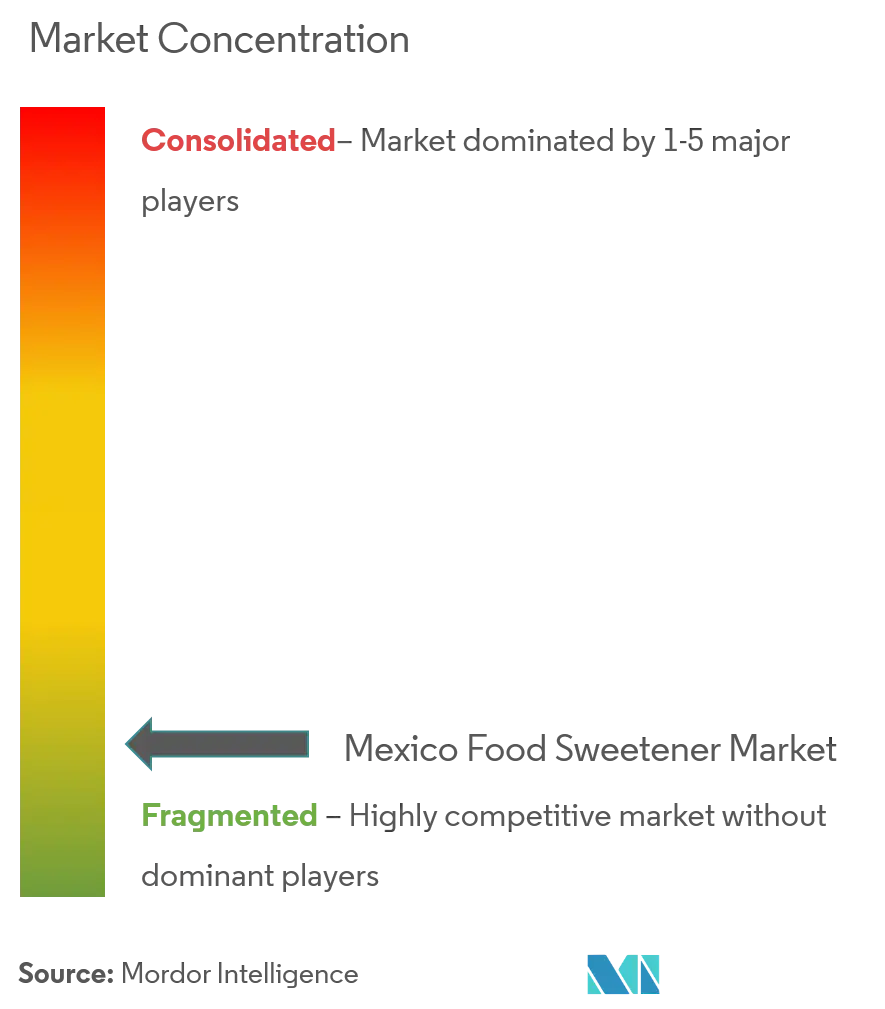
Recent Industry Developments
- Mar 2022: As Mexico's food safety agency adopted the Codex Alimentarius criteria for steviol glycosides made using various technologies, the natural sweetener firm Sweegen expanded into Mexico.
- Jan 2022: The Barentz Company, in partnership with ACT Polyols, started distributing rice-based sweeteners and proteins from ACT Polyols in North American states, including the United States, Canada, and Mexico. Among its uses are dietary supplements, confectionery, energy bars, deserts, desserts, and baked goods.
- Feb 2021: International Flavors & Fragrances Inc. ("IFF") completed the acquisition of DuPont's Nutrition & Biosciences business. The combined company continues to operate under the name IFF.
Mexico Food Sweetener Market Report Scope
A sweetener is a substance that is added to foods or beverages to give them the flavor of sweetness, either because it contains sugar or a sugar replacement with a sweet flavor.
Mexico's Food Sweetener Market is segmented by Type (Bulk Sweeteners (Sucrose, Fructose, High-Fructose Corn Syrup, Glucose, and Other Bulk Sweeteners) and Sugar Substitutes (Sucralose, Xylitol, Stevia, Aspartame, Saccharin, Thaumatin, and Other Sugar Substitutes)) and Application (Bakery, Confectionery, Beverages, Dairy and Frozen Products, Sauces, Soups, and Dressings and Other Applications). The report offers market size and values in (USD Million) during the forecast years for the above segments.
| Bulk Sweeteners | Sucrose |
| Fructose | |
| High-fructose Corn Syrup | |
| Glucose | |
| Other Bulk Sweeteners | |
| Sugar Substitutes | Sucralose |
| Xylitol | |
| Stevia | |
| Aspartame | |
| Saccharin | |
| Thaumatin | |
| Other Sugar Substitutes |
| Bakery |
| Confectionery |
| Dairy and Frozen Products |
| Beverages |
| Sauces, Soups and Dressings |
| Other Applications |
| Product Type | Bulk Sweeteners | Sucrose |
| Fructose | ||
| High-fructose Corn Syrup | ||
| Glucose | ||
| Other Bulk Sweeteners | ||
| Sugar Substitutes | Sucralose | |
| Xylitol | ||
| Stevia | ||
| Aspartame | ||
| Saccharin | ||
| Thaumatin | ||
| Other Sugar Substitutes | ||
| Application | Bakery | |
| Confectionery | ||
| Dairy and Frozen Products | ||
| Beverages | ||
| Sauces, Soups and Dressings | ||
| Other Applications | ||
Key Questions Answered in the Report
What is the current Mexico Food Sweetener Market size?
The Mexico Food Sweetener Market is projected to register a CAGR of 2.1% during the forecast period (2025-2030)
Who are the key players in Mexico Food Sweetener Market?
Cargill, Incorporated, Archer Daniels Midland Company, Ingredion Incorporated, Tate & Lyle PLC and International Flavors & Fragrances are the major companies operating in the Mexico Food Sweetener Market.
What years does this Mexico Food Sweetener Market cover?
The report covers the Mexico Food Sweetener Market historical market size for years: 2019, 2020, 2021, 2022, 2023 and 2024. The report also forecasts the Mexico Food Sweetener Market size for years: 2025, 2026, 2027, 2028, 2029 and 2030.
Page last updated on:
Mexico Food Sweetener Market Report
Statistics for the 2025 Mexico Food Sweetener market share, size and revenue growth rate, created by Mordor Intelligence™ Industry Reports. Mexico Food Sweetener analysis includes a market forecast outlook for 2025 to 2030 and historical overview. Get a sample of this industry analysis as a free report PDF download.
